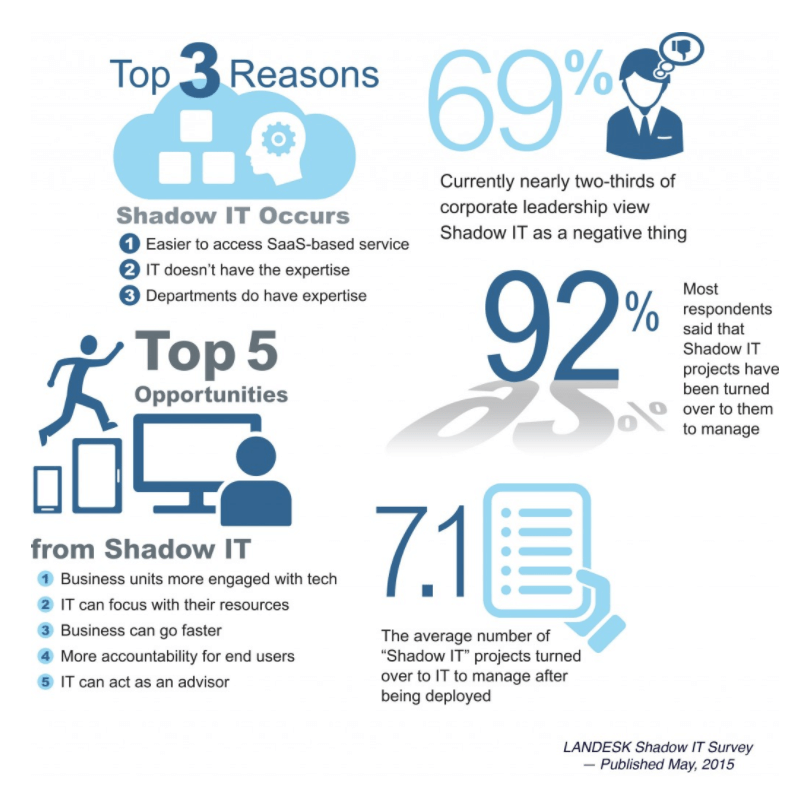Survey Results: The Role of Shadow IT in Your Organization
 We performed a survey this spring around the topic of Shadow IT. We asked a series of questions to which more than 275 respondents gave us answers. The respondents were mostly made up of people who manage or lead IT groups (70%), with a little more than half of the people (53%) being directors or department heads.
We performed a survey this spring around the topic of Shadow IT. We asked a series of questions to which more than 275 respondents gave us answers. The respondents were mostly made up of people who manage or lead IT groups (70%), with a little more than half of the people (53%) being directors or department heads.
There were a few data points that were surprising. The first surprise is that we expected that corporate management would be keener on getting things done, even if it means turning to Shadow IT solutions. However, the data showed that participants were nearly split within the IT ranks as to viewing Shadow IT as either negative (50%) or positive (45%). Meanwhile, the view of their management is far more negative with only 23% being positive on Shadow It and 69% seeing it as a negative.
The other surprise came from the realization that although IT may be in the dark when these Shadow IT initiatives are launched or adopted, departments will often turn their Shadow IT projects over to IT to manage them afterwards. Respondents indicated that 92% of them have inherited Shadow IT projects to manage and that the average number of projects they were managing, which started out as Shadow IT projects, was 7.1. Luckily, the participant’s IT organizations are receiving additional budget to manage these added projects, with all respondents indicating they’d had a budget increase.
The other insights we learned from the survey can be encapsulated in a series of “Top Five” lists. The numbers shown indicate the percentage of total respondents that selected a particular answer. Here are four Top Five lists:
Top five reasons Shadow IT occurs in organizations:
- Easier to get technology from an app store or SaaS-based service (73%)
- IT doesn’t have the specific solution expertise (44%)
- Certain teams or departments have technical expertise to implement technology solutions (41%)
- Business units have the budget to spend on whatever they need (22%)
- IT can’t meet a department timeline due to IT resource constraints or procurement (9%)
Top five opportunities organizations believe Shadow IT can create:
- Ability for IT to focus with the resources they have (44%)
- Business units are now more engaged in the technology that drives the business (44%)
- Business can more quickly reach objectives (41%)
- More accountability for end users with their technology (37%)
- IT can act more as an advisor or consultant (26%)
Top five ways IT discovers Shadow IT projects:
- Internal conversations and relationships (74%)
- Traffic monitoring (51%)
- Managed endpoint discovery (43%)
- Notified by your management (21%)
- When IT is asked to provide support on a device, software, or service (11%)
Top five things IT teams have done to overcome Shadow IT issues:
- Interact with teams after they’ve heard about a project (91%)
- Proactively search for new ideas or ways other organizations are doing things and take it to internal groups (47%)
- Set policies and processes to inform or involve IT (10%)
- Keep open dialogue with business units (8%)
- Hold regular meetings with business groups (8%)
In summary, most business management views Shadow IT as a negative, while IT organizations receive the brunt of Shadow IT after it’s been implemented because they’re later expected to manage the Shadow IT solutions. Shadow IT projects take place because they’re easy to access and are often preceded by some constraint on or by IT. The most impactful ways to detect and resolve issues has to do with building stronger relationships with users and business units. Proactively investigating new ideas and presenting them to the organization will also go a long way in reducing the risks of Shadow IT.
We recommend closing the gap between what people expect to gain from Shadow IT and what they can get from their corporate IT by providing stronger support, a wide breadth of services, and a more intuitive user experience.